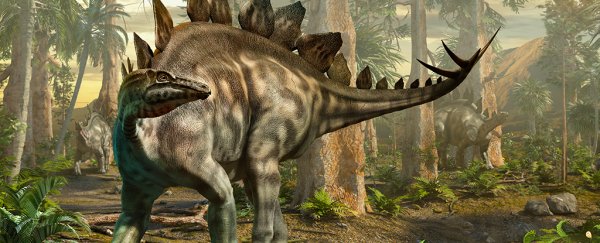Stand on the wind-swept crags lining Scotland's western coast today, and you'd be lucky to spot a puffin or two. But the closer we look, the more evidence we find it was once home to an incredibly diverse array of ancient beasts.
The discovery of new sets of fossilised tracks has expanded the list of potential dinosaur populations that roamed what is now the Isle of Skye. Among them are tracks left by an animal that would have belonged to one of the most famous plate-backed herbivore suborders, Stegosauria.
Scottish and Brazilian researchers have spent the past couple of years analysing two recently found tracksites at a spot on the island's north-eastern coast called Rubha nam Brathairean, or Brothers' Point.
"These new tracksites give us a much clearer picture of the dinosaurs that lived in Scotland 170 million years ago," says University of Edinburgh palaeontologist Stephen Brusatte.
Back then, the lands making up the British Isles were nothing like they are today. Jurassic Scotland sat far closer to the equator, roughly in alignment with where Greece is today. Warm seas and a sub-tropical climate established ecosystems that were bustling with life.
Still, just because it was a virtual paradise doesn't mean it's been perfect for preserving the remains of ancient life. The Jurassic isn't exactly fossil friendly as it is, but Scotland has always seemed especially thin on dinosaur tracks and bones.
In spite of a rich history of fossil hunting throughout much of the United Kingdom, the first clear traces of dinosaur wildlife in Scotland were finally uncovered in the early 1980s when palaeontologists John Hudson and Julian Andrews found the "unmistakable print from a large dinosaur" in a fallen limestone block at Brothers' Point.
Since then, a plethora of tracks belonging to a wide range of long-necked sauropods and fleet-footed theropods have been identified, turning the Isle of Skye into a landmark site for Jurassic researchers.
The most recent additions include teapot-sized holes that haven't been found elsewhere on the island – impressions that are described in palaeontological terms as belonging to a category called Deltapodus.
 Deltapod tracks on Isle of Skye (dePolo et al., PLOS One, 2020)
Deltapod tracks on Isle of Skye (dePolo et al., PLOS One, 2020)
"These discoveries are making Skye one of the best places in the world for understanding dinosaur evolution in the Middle Jurassic," says Brusatte.
Without a means of narrowing down the exact species of dinosaur responsible, the researchers are careful about jumping to any conclusions.
But it's fair to say that this group includes a type of cow-sized dinosaur famed for its lines of geometric plates adorning its spine, and a wicked clump of 'thagomising' spines on its tail.
The team also uncovered another potentially new addition to the list, in the form of large imprints of something with three stubby toes possibly belonging to a group of heavyweight herbivores called ornithopods.
"We knew there were giant long-necked sauropods and jeep-sized carnivores, but we can now add plate-backed stegosaurs to that roster, and maybe even primitive cousins of the duck-billed dinosaurs too," says Brusatte.
Not only do the tracks provide tantalising evidence that stegosaurs once trod along the muddy Scottish coastline, the age of the tracks provides some of the earliest evidence of this particular dinosaur's existence.
Only last year, a species of stegosaur was dug up in the Middle Atlas Mountains of Morocco. At an estimated age of around 168 million years old, the fossilised remains of Adratiklit boulahfa are officially the oldest of its kind.
These tracks at Brother's Point are closer to 170 million years old. While there's no way to confirm what kind of stegosaur might have left them behind, it does help establish timelines and distributions describing their evolution.
"In particular, Deltapodus tracks give good evidence that stegosaurs lived on Skye at this time," says the study's lead author, Paige dePolo from the University of Edinburgh.
With such a rich assortment of tracks being found across the island, this part of Scotland is representative of an important period in evolutionary history, where the late Jurassic's zoo of classic creatures was just beginning to develop their famous characteristics and spread out around the globe.
This research was published in PLOS One.
